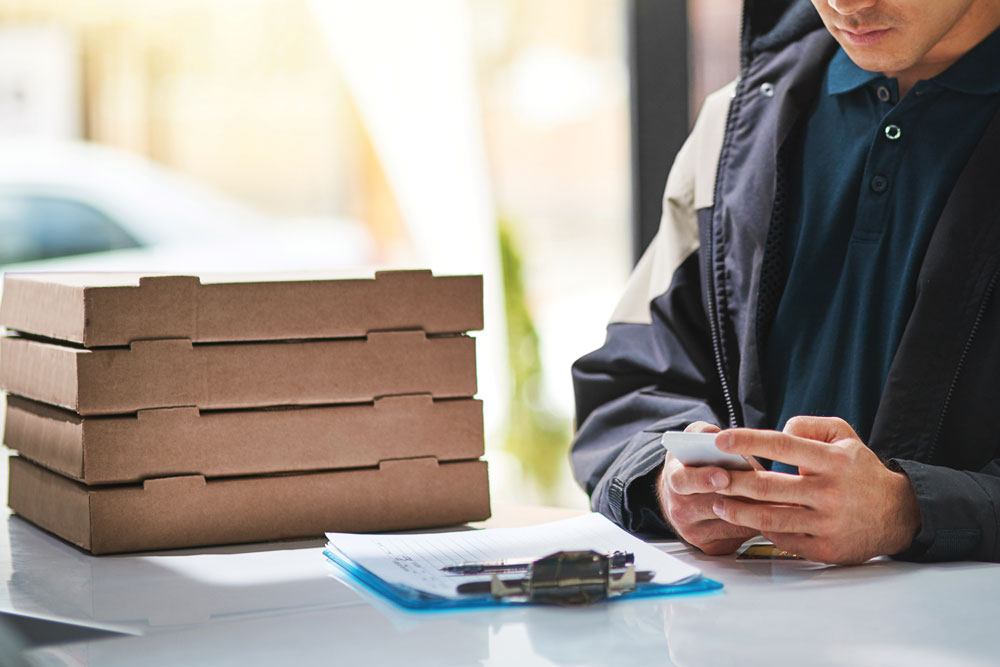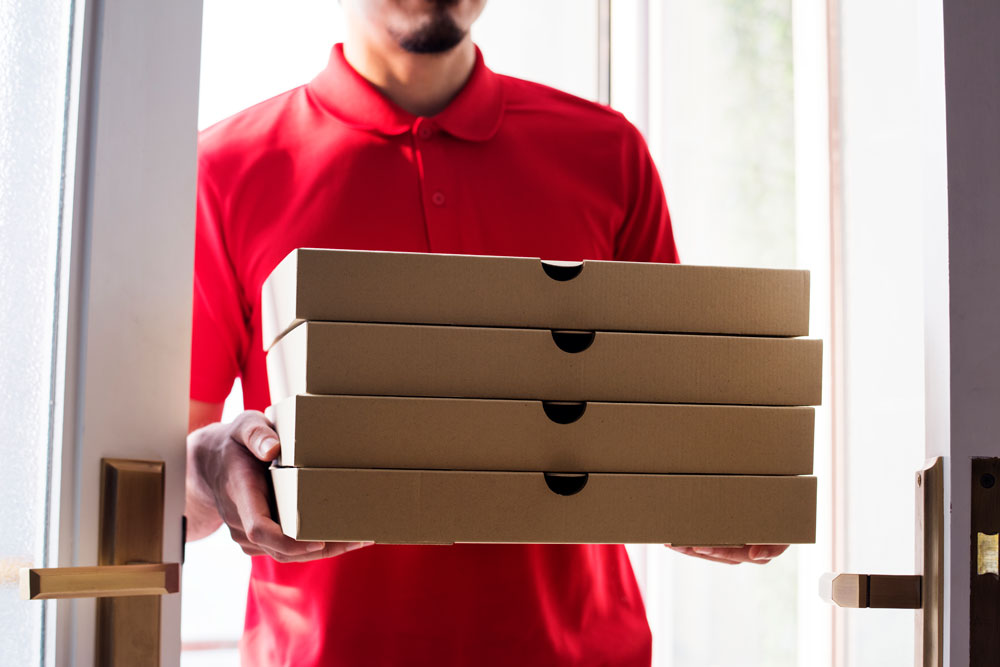Delivery is a time-honored hallmark of the pizza industry. However, offering delivery comes at a price. Hiring, training and employing delivery drivers adds labor costs to your pizzeria, not to mention the added cost of insurance. An alternative to delivery is to utilize a third-party delivery service.
There are essentially two types of third-party food services: Those that simply place an order with the restaurant, and those that pick up the food from the restaurant and deliver to the customer. Most third-party delivery services operate on a model of charging an extra fee (up to 30% of the ticket in some cases) for customers to place an order online or via an app. Some services require you to upload your customer database. Business owners should carefully weigh the advantages and disadvantages of this approach.
According to Bikky.com, an automated restaurant marketing platform based in New York City, the biggest third-party delivery services are GrubHub, with 15.1 million active users, and UberEats, with 8.7 million mobile app users. DoorDash, while having far less active users, has the second largest market share in third-party delivery.
An important factor to consider when evaluating third-party delivery services is your customer base. According to PMQ’s 2018 Pizza Power Report, “In a survey by AlixPartners, among those who order delivery, 71% said they prefer to get delivery directly from the restaurant, while only 8% said they prefer it through a third-party intermediary. There are also fees associated with third-party delivery that may not be worth it to your business if you already have in-house delivery drivers on the payroll.”
“It seems to be a decent option if you don’t do delivery yourself,” says Jamie Culliton, U.S. Pizza Team coach. “I have a couple of friends around the country who don’t do delivery, because they can’t find a driver. So it’s a good option when you are in a situation like that. I do know they take a pretty hefty cut out of your ticket to deliver it. So that would be the downside—losing that money instead of just having a delivery driver yourself. But then again, you don’t have to pay the insurance with a delivery driver, which is always a pain.”
Is a third-party delivery service right for you? And once you commit, how should you proceed? Here are some things to consider:

Avoid the pitfalls. Kamron Karrington, founder and CEO of Repeat Returns, a marketing agency in Las Vegas, warns of some of the dangers of utilizing third-party delivery services, particularly if they require you to upload your customer database. “With any of these third-party platforms, you can be paying 30% to upload your customers to a platform where your competitors can begin poaching them,” Karrington says. “If you presented this to a merchant that way, they’re going to say no. But that’s not how it’s pitched. It’s pitched, ‘We have all these people who want to order, and they’re going to see your restaurant,’ so you sign up. But, while you’re on board, you are transferring either your customers or people who are ordering from you to a third-party provider who is now promoting your competitors to your customers.”
Karrington also warns of the seductive nature of third-party platforms. “They’ve got you addicted to this, and now it’s going to be hard to leave,” he says. “You’ve uploaded all your customers to them, and if you stop, your customers will be ordering from others.”
To successfully make the switch, Karrington recommends finding what he terms as a “conversion path” from the third-party services to your dedicated online ordering platform, weaning the consumer from the third-party app to ordering directly from you. “If you’re doing your own delivery, you can include a box topper aimed at moving a third-party user to your online ordering site,” Karrington says. “You can say, ‘Order direct at our website and get $5 off your next order.’ That gets them to move to your site the next time. If you’re using third-party delivery, those services are not too keen on you trying to steal their customers away and getting them to order directly through you.”
— Bruce Irving
Convert your customers. Use unique delivery packaging specifically for third-party delivery to convert customers to your loyalty program. “If you’re using a box topper, that can disappear on the way to the customer’s house,” Karrington says, “so print specific boxes or to-go containers for those customers who are ordering through that channel. Print the pitch on there: ‘Join our loyalty program and start earning rewards each time you place an order.’”
Karrington recommends a good signup offer to entice customers. In a welcome email, make it clear to them that to earn points and redeem offers for online orders, they must order from your website (include the link in the email).
| Add-On Assets |
|
Some POS manufacturers, such as Par Technology, based in New Hartford, New York, have equipment that can automatically coordinate third-party delivery services with your restaurant’s POS system, greatly simplifying the process of utilizing these services. Slice, an online ordering platform based in New York City that's designed to promote smaller, independently owned pizzerias, says about 40% of their order volume is for pickup and takeout, not delivery, according to their analytics. |
Weigh the pros and cons. Pizzeria owners should carefully evaluate the advantages and disadvantages of third-party delivery services. For example, Bruce Irving of Smart Pizza Marketing, a digital agency in Boston, believes that third-party delivery services are great if you’re a small, local pizzeria with no real digital footprint. “The problem that happens with more established restaurants and pizzerias is that it takes away from your own online ordering system,” he says. “If you do have your own online ordering, it could be a mistake to promote third-party services.”
In these cases, Irving recommends using third-party services as a way to be found, like you would on Google, when someone searches the third-party site for pizza. “Once that customer orders from you through the third-party platform, do anything and everything you can to get them to order directly from you the next time,” Irving says. “Then you have their email, phone number, address, all that data—but these third-party services may take those customers who order from you and promote that customer to other businesses, which may be competitors of yours.”
Lenny Rago, co-owner of Panino’s in Chicago and a U.S. Pizza Team member, poses another angle to consider, along with a personal anecdote: “Are third-party companies taking other establishments’ orders and grouping them, causing deliveries to be late?” asks Rago. “I ordered at my house one time and got someone who could barely understand me, and I couldn’t understand them. They didn’t have direct contact with the restaurant. When the customer calls third-party companies with high volume, they can be put on hold forever.” Further issues have happened to Rago as a customer: Once, a driver set the food at the wrong house, left it outside in freezing temperatures, and by the time he got through to customer service and she delivered it to the correct address, the food was ice-cold. Such mistakes can potentially reflect poorly on your brand.
Promote your brand. Irving believes that operators with a social media footprint, mobile-friendly website and online ordering are less likely to need third-party delivery. “Aggressively market those things on social media, on Facebook, on Instagram, through your email, and offline if you do fliers or door hangers,” he advises. “Promote the fact that you have your own delivery and your own online ordering system, and make it easy for people to use. The reason those third-party delivery platforms are so popular is that the ease of use for the consumer is great on those platforms. For most pizzerias, it’s not.”
Karrington notes that it may be beneficial to outsource delivery—but only if it makes sense for your operation. “If you have a service that is making you look good, and saving you money and hassle, that completely makes sense,” he says. “Just don’t give up the biggest asset you have, your customer database. That’s a bad trade.”
Bill DeJournett is PMQ’s managing editor.













